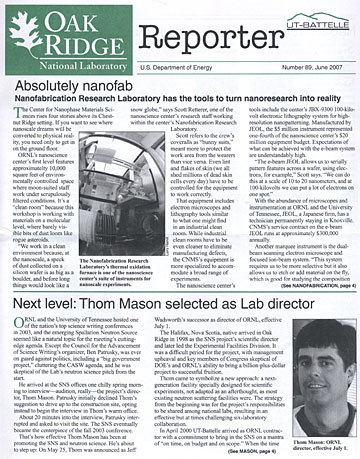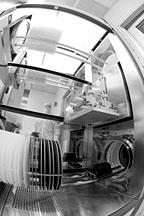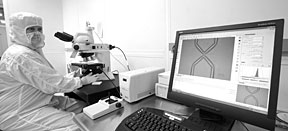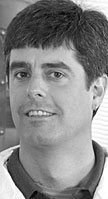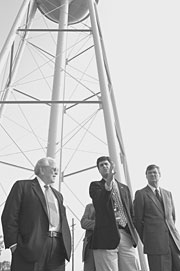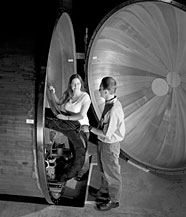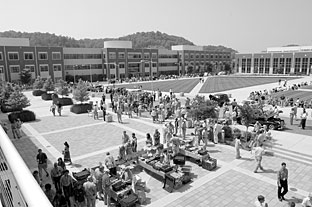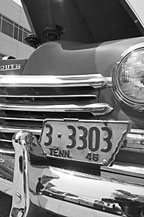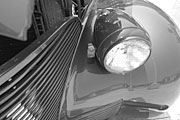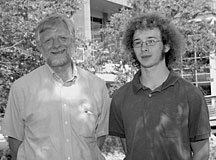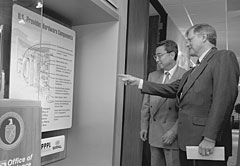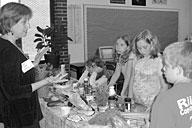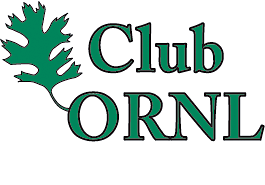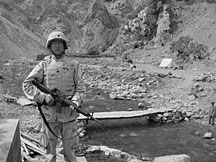 |
Number 89, June 2007 |
 Absolutely nanofab
Absolutely nanofab
Nanofabrication Research Laboratory has the tools to turn nanoresearch into reality
|
|
The Nanofabrication Research Laboratory’s thermal oxidation furnace is one of the nanoscience center’s suite of instruments for nanoscale experiments. |
The Center for Nanophase Materials Sciences rises four stories above its Chestnut Ridge setting. If you want to see where nanoscale dreams will be converted to physical reality, you need only to get in on the ground floor.
ORNL’s nanoscience center’s first level features approximatelty 10,000 square feet of environmentally controlled space where moon-suited staff work under scrupulously filtered conditions. It’s a “clean room” because this workshop is working with materials on a molecular level, where barely visible bits of dust loom like rogue asteroids.
“We work in a clean environment because, at the nanoscale, a speck of dust collected on a silicon wafer is as big as a boulder, and before long things would look like a snow globe,” says Scott Retterer, one of the nanoscience center’s research staff working within the center’s Nanofabrication Research Laboratory.
Scott refers to the crew’s coveralls as “bunny suits,” meant more to protect the work area from the wearers than vice versa. Even lint and flakes of skin (we all shed millions of dead skin cells every day) have to be controlled for the equipment to work correctly.
That equipment includes electron microscopes and lithography tools similar to what one might find in an industrial clean room. While industrial clean rooms have to be even cleaner to eliminate manufacturing defects, the CNMS’s equipment is more specialized to accommodate a broad range of experiments.
The nanoscience center’s tools include the center’s JBX-9300 100-kilovolt electronic lithography system for high-resolution nanopatterning. Manufactured by JEOL, the $5 million instrument represented one-fourth of the nanoscience center’s $20 million equipment budget. Expectations of what can be achieved with the e-beam system are understandably high.
“The e-beam JEOL allows us to serially pattern features across a wafer, using electrons, for example,” Scott says. “We can do this at a scale of 10 to 20 nanometers, and at 100-kilovolts we can put a lot of electrons on one spot.”
With the abundance of microscopes and instrumentation at ORNL and the University of Tennessee, JEOL, a Japanese firm, has a technician permanently staying in Knoxville. CNMS’s service contract on the e-beam JEOL runs at approximately $300,000
annually.
Another marquee instrument is the dual-beam scanning electron microscope and focused ion-beam system. “This system requires us to be more selective but it also allows us to etch or add material on the fly, which is good for studying the composition of the nanomaterial. You can cut off a section of something and look inside it, layer by layer,” Scott says.
|
|
A “bunny-suited” Laura Edwards works at a Nikon optical microscope used for the visualization and characterization of microstructures. |
The challenge of nanoscience is to figure out ways to make the molecules arrange themselves to do the work we want them to do. In “our world,” as Scott refers, these are typically assembly processes where machines or materials are simply put together. At the nanoscale, instruments such as the e-beam lithography system can help arrange materials in patterns that will cause molecules to assemble into a desired configuration.
“Avoiding the ‘big sticky fingers’ problem requires this very specialized tool set,” Scott says. “It lets us bridge the gap between the mesoscale—our world—and the nanoscale. And instead of looking at, for instance, nanotubes in bulk, we can measure properties of individual nanotubes.”
Those processes include lithography—or writing a pattern—and etching, or removing material. The nanofabrication laboratory’s work is generally a process of either depositing or arranging molecules on a surface or etching or removing layers and then analyzing the result. The clean area is configured that way, in a “bay and chase” arrangement with bays dedicated to deposition, etching and analysis.
“In the real world the task is basically brick-and-mortar, where you physically build the building. In nano, the building has to build itself; in other words, you make molecules or molecular elements arrange themselves into functional assemblies,” Scott says.
“This tool set allows us to build at a nano scale, layer by layer, and to see what we’re doing, which is invaluable.”
The CNMS is organized into research themes of Macromolecular Complex Systems; Functional Nanomaterials; Catalysis and Nano-Building Blocks; NanoPhysics: Magnetism, Transport, and Scanning Probes; and Bio-Inspired Nanomaterials. The suite of instruments in the nanofabrication lab is set up to support all of the them. The nanoscience center also works closely with facilities on the main campus, including another clean room in Building 3500.
In operating as a user facility, the nanoscience center team is faced with a balancing act between keeping the facility available to users (250 expected in 2008) and ensuring the safety of these users and the facility. Researchers work with chemicals similar to what one would find in a typical clean room, but “serious substances” nonetheless, including cleaning agents xylene, pyrophoric acid and hydrofluoric acid. Emissions are scrupulously controlled. Operators of the high-dollar instruments are trained and retrained to make sure they are properly used.
“I make sure the people can use the e-beam JEOL properly before I turn them loose with a $5 million toy,” an understandably protective Scott says. “It’s a struggle to balance an open facility that’s getting consistently good results with having enough restrictions to ensure a safe working environment.
“But that’s true for any scientific facility,” he says.—B.C. ![]()
 Next level: Thom Mason selected as Lab director
Next level: Thom Mason selected as Lab director
|
|
Thom Mason: ORNL director, effective July 1. |
ORNL and the University of Tennessee hosted one of the nation’s top science writing conferences in 2003, and the emerging Spallation Neutron Source seemed like a natural topic for the meeting’s cutting-edge agenda. Except the Council for the Advancement of Science Writing’s organizer, Ben Patrusky, was ever on guard against politics, including a “big government project,” cluttering the CASW agenda, and he was skeptical of the Lab’s neutron science pitch from the start.
He arrived at the SNS offices one chilly spring morning to interview—audition, really—the project’s director, Thom Mason. Patrusky initially declined Thom’s suggestion to drive up to the construction site, opting instead to begin the interview in Thom’s warm office.
About 20 minutes into the interview, Patrusky interrupted and asked to visit the site. The SNS eventually became the centerpiece of the fall 2003 conference.
That’s how effective Thom Mason has been at promoting the SNS and neutron science. He’s about to step up: On May 25, Thom was announced as Jeff Wadsworth’s successor as director of ORNL, effective July 1.
The Halifax, Nova Scotia, native arrived in Oak Ridge in 1998 as the SNS project’s scientific director and later led the Experimental Facilities Division. It was a difficult period for the project, with management upheaval and key members of Congress skeptical of DOE’s and ORNL’s ability to bring a billion-plus-dollar project to successful fruition.
Thom came to symbolize a new approach: a next-generation facility specially designed for scientific experiments, not adapted as an afterthought, as most existing neutron scattering facilities were. The strategy from the beginning was for the project’s responsibilities to be shared among national labs, resulting in an
effective but at times challenging six-laboratory
collaboration.
In April 2000 UT-Battelle arrived as ORNL contractor with a commitment to bring in the SNS on a mantra of “on time, on budget and on scope.” When the time came in February 2001 to name a new SNS director, the earringed Canadian was selected to make it all happen.
It did happen on April 28, 2006, when the SNS, in Thom’s words, became “officially a neutron source.”
As Lab director, Thom will now oversee the largest Office of Science multiprogram laboratory in the DOE realm, with thriving programs in computing, biology, materials, physics and energy technologies. It’s not as big a reach as it seems: All of those areas are multidisciplinary, and most have a neutron science element.
“Given that the public dialogue on energy has become so broadly defined as to include climate change and sustainability, as well as economic competitiveness and technological advancement, ORNL’s range of disciplines and capabilities makes it exceptionally well positioned for a leadership role,” Thom says.
|
|
Thom Mason (center) has explained the Spallation Neutron Source and neutron scattering science to many people, including former Tennessee Senator Howard Baker (left), shown here with departing Lab Director Jeff Wadsworth. |
In fact, far from being isolated by the monumental task on Chestnut Ridge, from his first days as SNS director Thom has urged Lab researchers across disciplines to take advantage of what the SNS would offer. In one sign of success, numerous valley-bound Lab researchers are now co-located at the adjacent Center for Nanophase Materials Sciences.
He has also reached out to the community. Living in Oak Ridge with his wife, Jennifer, and two school-age sons, Thom was an early proponent of the drive to renovate the city’s high school. He chairs the Oak Ridge Public Schools Education Foundation, which helped in raising $55 million for the project.
Schooled at Canada’s Dalhousie and McMaster universities, Thom became a U.S. citizen last year. His accolades before coming to ORNL include Alfred P. Sloan Research Fellow, associate of the Canadian Institute for Advanced Research, associate professor at the University of Toronto, senior scientist at Denmark’s Risø National Laboratory and a postdoctoral fellow with Bell Laboratories.
Up until May 25, Thom’s most recent ORNL promotion was to lead the Lab’s new Neutron Sciences Directorate, which combines the SNS with the newly revamped High Flux Isotope Reactor, giving ORNL a world-class, one-two neutron science punch.
Many noteworthy individuals have received their introduction to neutron science from Thom, often on the hilltop overlooking the SNS. Former U.S. Senator and Ambassador Howard Baker received such a VIP tour from Thom in 2003. During a lull in the presentation, the elder statesman looked across the coach seat at the youthful SNS director.
“How old are you?” Baker asked, a little incredulously.
For the record, Thom is 42.—B.C. ![]()
 Nagler, Norby named UT-Battelle Corporate Fellows
Nagler, Norby named UT-Battelle Corporate Fellows
|
|
Nagler |
Steve Nagler, chief among the Lab’s neutron scattering scientists, and Rich Norby, who leads ORNL’s experimental ecology effort, are ORNL’s newest UT-Battelle Corporate Fellows.
Steve Nagler joined the former Solid State Division’s Neutron Scattering Group in 1995 and served as group leader for Neutron Spectrometry from 1996 to 2005. During that period, as interim director of the High Flux Isotope Reactor Center for Neutron Scattering, Steve guided the center through a critical DOE review while ensuring research productivity, successful instrument upgrades and integration of neutron scattering at HFIR and the Spallation Neutron Source.
Last year the American Physical Society fellow was named chief scientist for the new Neutron Scattering Science Division to oversee development and implementation of strategies for ORNL leadership in neutron sciences. He is principal investigator for the $17 million SEQUOIA spectrometer at SNS, which will enable unprecedented materials studies impacting high-temperature superconductors, alloys, thermoelectric materials and other areas.
|
|
Norby |
Rich Norby joined the Environmental Sciences Division as a postdoctoral research fellow in 1981 and was appointed to the ORNL research staff in 1985. He is currently the science team leader for Experimental Ecology.
A fellow of the American Association for the Advancement of Science, Rich is one of the leading researchers in the world on the effects of increasing levels of atmospheric carbon dioxide on terrestrial ecosystems. He is a pioneer in large-scale manipulative field experiments and led the design and implementation of the ORNL Free Air Carbon Dioxide Enrichment (FACE) facility, which has established the importance of understanding allocation of carbon to root systems as an ecosystem response to elevated carbon dioxide levels.
Rich was one of the earliest researchers to recognize the crucial importance of root and soil processes in mediating the response of trees to carbon dioxide, and his research has profoundly influenced the direction of global carbon studies. He is environmental section editor of New Phytologist.—Mike Bradley ![]()
 Revamped, renewed, restarted: HFIR’s back on line
Revamped, renewed, restarted: HFIR’s back on line
The High Flux Isotope Reactor is back in action and better than ever. After $70 million in renovations and more than a year of meticulous system checks, HFIR was restarted in May and taken to its 85 megawatts of full power.
“The restart has gone well,” says Kelly Beierschmitt, HFIR executive director. “This reactor’s design is rigorous and robust. Its performance has been stellar from both an operational and a safety perspective.
“We still have work to do, but we are extremely pleased with our progress so far.”
Built in 1966, HFIR is internationally known as a neutron source for materials studies and isotope production.
The reactor returns with a suite of new experiment instruments, beam lines to channel neutrons, a new beryllium reflector, and other upgrades.
Powerful refrigeration systems were added to cool the reactor’s neutron beams to minus 425 degrees Fahrenheit. The intense cold slows the neutrons and lengthens their wavelength, allowing scientists to study “soft” materials such as proteins and polymers and to analyze materials with certain magnetic properties.
|
|
The Neutron Scattering Sciences Division’s Daniel Maierhafer and Katherine Atchley examine one of the small angle neutron scattering tanks. |
- Experiments to create new materials with beneficial properties, based on polymer nano-composites, which are “hard” nanoparticles surrounded by a “soft” polymer matrix.
- Studies to make crystals from membrane proteins, which determine interaction and communication between living cells, to better understand the membrane proteins’ structure and function.
- Examination of how high-pressure carbon dioxide is absorbed by and migrates through different types of coal to help develop new, more efficient ways to sequester CO2 to reduce greenhouse gas emissions.
Neutrons are vital to research in physics, chemistry, engineering and other materials-related fields. At room temperature, they are ideal for use in special instruments to illuminate the atomic structure and dynamics of hard, dense materials.
HFIR’s cold source will complement the capabilities of ORNL’s recently completed Spallation Neutron Source, the world’s premier neutron science facility.—Mike Bradley
 |
 Just pick up the phone
Just pick up the phone
People were probably wondering what all the fuss was about, since the phones were working. But a mechanical failure in the ORNL telephone system on the afternoon of May 22 had the potential to shut the Lab down the next day. Or two.
Telephone systems run on DC current supplied by batteries. That evening a bank of four power supplies that charge the ORNL system’s batteries failed in unison, leaving the ORNL phones slowly running down, like an auto with a failed alternator. Replacement parts weren’t available locally; they had to be shipped from Ohio, a half-day away, not counting a complex installation.
A situation assessment team began checking into what was affected. The answer was more than you’d think. Because of how the Lab system is configured, the failure would have silenced land lines, most local cell phone service, 911 service and, it was believed at the time, the Lab’s public address system.
“We would have been flying blind, with no way to notify or be notified if we had an emergency,” says Facilities Management Division Director Jimmy Stone, who was also heading the situation assessment team. The only stand-by available was the fire-alarm pull boxes, and even some of those in outlying facilities were affected.
While Lab officials were deciding Tuesday night whether to stay open, FMD staff members, working with Qwest, the DOE phone system contractor, were able to revive the power supplies enough to keep the phone system going, if on a wing and a prayer.
Most Lab staff members, despite the messages at the vehicle entrances, on doors and in ORNL Today, experienced a fairly “transparent” crisis: Dial tones and cell signals remained strong through midnight Thursday, when the new rectifiers were installed.
The near-miss was a valuable lesson on the Lab’s communications system configuration. In the meantime, Jimmy praised all the staff members across organizations who worked to avert an expensive unscheduled holiday.
“We had people here for long hours and in the middle of the night, staying with it until it was fixed, and we didn’t have to ask them to do it. More importantly, they did it safely,” Jimmy says.
 Losing ground on CO2 emissions
Losing ground on CO2 emissions
A paper co-authored by the Environmental Sciences Division’s Greg Marland and published in the Proceedings of the National Academy of Sciences struck a chord with a climate-change-attentive public in May. The article, titled “Global and Regional Drivers of Accelerating CO2 Emissions,” reported that carbon dioxide emissions have accelerated sharply since 2000.
The paper, which included data from ORNL’s Carbon Dioxide Information and Analysis Center, cited fossil fuel emissions as the dominant cause. Although emissions in the west have leveled, China and India’s CO2 emissions have accelerated with their booming economies. The article notes that “no region is decarbonizing its energy supply.”
The article’s lead author is Michael Raupach of Australia’s Commonweath Scientific and Industrial Research Organization, who worked with Gregg and researchers from France, England, Germany and the United States.
—Reported by Bill Cabage |
|
||||||
|---|---|---|---|---|---|---|
|
||||||
 Roane County High School student, Platfoot, receives UT-Battelle scholarship
Roane County High School student, Platfoot, receives UT-Battelle scholarship
|
|
UT-Battelle Scholarship winner Mark Platfoot (right) with dad, John. |
Mark Platfoot of Roane County High
School has received the 2007 UT-Battelle Scholarship worth up to $20,000.
Mark has participated in math, science and scholars bowls and plans to pursue a career in nuclear engineering. Mark played the tuba in the marching and concert bands. In addition, he earned a green belt from Keko’s Academy of Martial Arts and is an Eagle Scout in Kingston Boy Scout Troop 101.
Academically, Mark received accolades for earning outstanding scores in advanced placement calculus and numerous other classes. He graduated with a 3.97 grade point average. One teacher considers him to be in the top two percent of students he has taught in the last 10 years.
In his essay, Mark writes that it is one of his goals to be among the people who help bring the United States into a new age of energy. “I plan to use my career in nuclear engineering to improve the general American’s lifestyle by helping to use a tested, reliable energy source to reduce the cost of energy,” he writes.
The UT-Battelle scholarship is a competitive award presented annually to the child of an ORNL employee. The scholarship is awarded in $5,000 annual increments over a four-year period to an outstanding graduating high school student who plans to study science, mathematics or engineering at the University of Tennessee.
Mark is the son of John Platfoot and Rosemary Mattson of Kingston. His father works in the Nuclear & Radiological Protection Division. ![]()
 ITER director general visits Oak Ridge
ITER director general visits Oak Ridge
|
|
ITER Director General Kaname Ikeda (left) and U.S. ITER Project Manager Ned Sauthoff view a display of components that the U.S. office will provide for the experimental device. |
Japan’s Kaname Ikeda, director general of the ITER international fusion power research and development project, met May 17 with managers of the U.S. ITER Project Office in Oak Ridge to discuss progress and issues related to the collaborative effort.
ITER – Latin for “the way” – involves a scientific collaboration between the United States, China, the European Union, India, Japan, Korea and Russia. It is expected to be completed by 2016 at a site in Cadarache, France.
The U.S. ITER Project Office is hosted by ORNL with partners Princeton Plasma Physics Laboratory and Savannah River National Laboratory. The United States will contribute hardware components, personnel for the international team and funding for ITER assembly, materials and infrastructure.
During his first trip to Oak Ridge, Ikeda met with leaders of the U.S. project, local DOE officials and representatives of project partner organizations.
He also toured ORNL’s Leadership Computing Facility, which supports the U.S. ITER effort, and the Spallation Neutron Source.—Cindy Lundy ![]()
 ORNL People
ORNL People
|
|
Lee Gunter explains how plants affect our lives to Linden Elementary School students. Lee, Carla Gunderson and Sara Jawdy from the Environmental Sciences Division took part in the school’s Science Day. |
The Materials Science & Technology Division’s Karren More and Amit Goyal have been elected fellows of the American Ceramic Society. They will be formally recognized at the ACerS’s 109th annual meeting, which is being held this year in Detroit in mid-September.
Corporate Fellow David Greene, of the Transportation Policy & Planning group in the Engineering Science & Technology Division, was awarded the 2007 Barry D. McNutt Award, “for excellence in automotive policy analysis,” during the Society of Automotive Engineers Government/Industry Meeting in Washington, D.C. In addition, David and Paul Leiby, team leader, Energy Analysis, Environmental Sciences Division, received the 2007 DOE Hydrogen Program R&D Award, “in recognition of outstanding contributions to hydrogen scenario analysis.”
Facilities Development Division Director Lanny Bates has accepted the position of associate laboratory director for facilities and operations at Brookhaven National Laboratory. Lanny’s move north to Long Island, N.Y., is effective July 1. Dell Morgan will serve as FDD’s acting director. ![]()
 Letters
Letters
ORACLE could float
It is true that the ORACLE had no hardware floating-point capability (Reporter No. 88, “ORACLE vs. Jaguar: The eight-hour day”), but it had a set of subroutines that carried out floating-point arithmetic. Many floating-point calculations were done in several different scientific and engineering projects.
Bill Nestor
Oak Ridge
 Mayo Clinic results
Mayo Clinic results
Lifestyle choices weigh heavily on health; so does reducing risk factors
by JOAN LAWSON
ORNL Wellness Coordinator
Results are in from the Mayo Clinic Health Risk Assessment (HRA) and the launch of the new wellness website, and Mayo Clinic has provided ORNL with an overview of the aggregate data. Remember that ORNL does not receive any personal information, only a group report that is a pool of all the responses submitted in the Mayo Clinic HRA and the web usage data.
Of the 1,297 who registered on the e-health site, a little over half, 684, also took the HRA. Regrettably, this is only about 16 percent of employees, which limits our ability to fully understand the health status of the ORNL employee population as a whole. But, as a first year, voluntary effort, the HRA numbers offer some useful insights and guidance and provide a good start toward developing a strong wellness program that can impact the health and well being of employees and their families.
|
|
Programs such as May’s HealthFest are aimed at imrpoving the health and wellness of Lab staff. Karen Atchley (left) and Lori Muhs check out the month’s activities at an event emceed by ESH&Q Director Karen Downer. |
As an example, the HRA data allows for a comparison of perceived health versus actual health. Within our data set, 57 percent reported they were in excellent health, yet 55 percent had five or more multiple risk factors. Regardless of which segment of our population submitted information, these results indicate ORNL has at least 375 employees with real and immediate health concerns that need to be addressed.
The disconnect between perceived and actual health suggests that we are not fully aware of the extent to which our lifestyle choices impact our health. The reality is that unhealthy lifestyle behavior accounts for 40 to 50 percent of all illness and death in the U.S. These are lifestyle behaviors that we as individuals can control and modify.
Furthermore, the runaway increases in U.S. health care costs have been tracked to an increase in the occurrence of lifestyle-based diseases and the cost of treatment for those diseases.
Take obesity for example. Many of us grew up as members of the clean plate club and learned that we were expected to eat everything on our plates. We’ve carried the habit into adulthood and, worse yet, we’ve taught our children to do the same. This behavior is a contributing factor in the obesity epidemic in the U.S., which not only costs $117 billion in U.S. medical spending each year but also doubles the rate of worker’s compensation claims.
According to a study by Duke University, just published in the Archives of Internal Medicine, obese workers had 13 times more lost workdays due to work-related injuries and their medical claims for those injuries were seven times higher than those for their fit co-workers. Overweight workers were more likely to have claims involving injuries to the back, wrist, arm, neck, shoulder, hip, knee and foot than other employees.
ORNL is certainly concerned about the cost of health care, but of equal concern is the health of those who work at the Lab. As a research institution, the excellence that ORNL enjoys is based on employee creativity and innovation, and maintaining that level of excellence is directly related to the level of health and well being of ORNL staff. The impact of employee health extends well beyond the direct costs of healthcare and the indirect costs of absenteeism, disability, and safety.
What can ORNL do to help employees maintain or improve their health? The HRA data provides some direction. Mayo Clinic examines two categories of risk factors—medical and lifestyle. Those assessed in the HRA were
Medical: blood pressure, blood sugar, cholesterol, triglycerides and weight
Lifestyle: alcohol use, emotional health, exercise, nutrition, safety and tobacco use.
Weight and blood pressure were our greatest medical risk factors while nutrition and safety were our highest lifestyle risk factors. Twenty years of research at the University of Michigan’s Health Management Research Center has shown that reducing risk factors not only improves health but also reduces healthcare costs.
The elimination of just one risk factor reduces costs by an average of $2,500 per person per year according to the Michigan HERO Study. Furthermore, the cost when an employee adds a health risk factor (e.g., becomes overweight) is twice as high as the savings when an employee eliminates a health risk factor. Therefore it is important to help healthy employees stay healthy, as well as to help unhealthy employees make changes.
Are we ready to do something about avoiding or reducing our risks? Our HRA data indicates that about 20 percent are ready to focus on exercise, 17 percent are interested in weight loss and 14 percent are ready to make changes in nutrition and diet. These numbers might seem small but, if it were possible to apply these results across the entire Lab, they would mean over 800 employees are ready to participate in work-based exercise programs, 680 are ready to lose weight, and 560 want help with nutrition. If we were able to reduce risk factors by just one for half of the 4,000 employees at the Lab, that would result in $5 million in health care cost reductions and significant health and quality of life improvements for staff.
These are goals worth aiming for. They are the goals the Wellness Program and ORNL Benefits are striving to address through a multiyear, holistic, integrated health management approach that targets the health and health- risk needs of our diverse work force. The monthly Health Series of lectures and screenings, the annual Benefits and Wellness Fair each fall; the new Mayo Clinic Web-based wellness program; Matria’s Personal Health Assistance for disease management; and the exercise, nutrition and weight-loss campaigns and events offered throughout the year are some of the programs developed to engage employees and encourage participation.
But simply offering a variety of programs and opportunities may not be enough. The HRA data are in, and they target what our health management priorities should be. Now the challenge is to create awareness, acceptance and support for a wellness standard of excellence for the Laboratory that inspires participation in our wellness programs. ![]()
Contact Joan Lawson at (865) 576-9120, lawsonjw@ornl.gov.
 Historic? Maybe. Get outbound material evaluated
Historic? Maybe. Get outbound material evaluated
ORNL’s cultural resources coordinator, James Hall, needs your input in helping identify significant historical machinery, equipment and other appropriate objects, photographs, media and documents associated with ORNL’s role with the World War II Manhattan Project and the Cold War era.
Says James, “Make sure that historic materials are not discarded or destroyed before they have been properly evaluated. Your input will be documented and will help accommodate key sections of a programmatic agreement among ORO, the Tennessee State Historic Preservation Office and the Advisory Council on Historic Preservation.”
Contact James at 576-4211, hallja1@ornl.gov, to arrange a time to assess items that you suspect might be historical artifacts.
 New Staff
Members
New Staff
Members
Tolga Aytug, Chemical Sciences
Michael Chad Burkhart, John Casey Beeler, David Shay Bowers and Brandon Scott Lee, Craft Resources
Petro Maksymovych and Felicia Dair Bellamy-Roseberry, Materials Science & Technology
Michael Jackson, Tina Louise Overby, Gregory Lee Pollard and Steven Michael Hobson, Information Technology Services
James Paul Szybist and Zhiming Gao, Engineering Science & Technology
Erin Georgette Wilkerson, Environmental Sciences
Shaun Norman Cooper and David Brent Leffew, Research Accelerator
Jana Sue Horton and Erica Marie Whitehead, Human Resources Dir.
Sylvia Ellen McLain, Christopher Bryan Stanley, Landon Michael Solomon and Don Erik Stringfellow, Neutron Scattering Science
Ram Hemant Datar, Biosciences
Stanton A. Fears and Amanda Jessica Novak, Asset Mgt & Small Business Programs
Kim Douglas Handy, Neutron Facilities Development
Blair Elizabeth Irby, Accounting
Marc Thomas Filigenzi, Legal Dir.
Jennifer Anne Juergens and Tasia Renee Spencer, Contracts
Bryan DeWayne Smith, Business & Information Services Dir.
Adam Joseph Carroll, Nuclear Science & Technology
Jeffrey McKinley Jessie, Logistical Services
Stephen Wayne Hodson, Center for Computational Sciences
 Three tours: Mulkey keeps volunteering for tough job
Three tours: Mulkey keeps volunteering for tough job
|
|
Eric Mulkey stands near a bridge construction site in Salang Valley, Afghanistan, during an inspection of the project in October 2006. |
Eric Mulkey, a civil engineer in the Environmental Protection & Waste Services Division, returned from Afghanistan in April after his third voluntary deployment as an Air Force reserve officer.
“When I deploy, I feel I’m doing something that is more important than either my typical reserve duty or civilian job. I was in the reserve 19 years before I deployed, and that time was fine, but it wasn’t much different than being a civilian engineer. You were still in America living a regular life,” Eric says.
He spent his first deployment in Afghanistan from October 2003 to March 2004 and made a November 2004 to April 2005 tour of duty in Iraq. He then returned to Afghanistan in April 2006 for a yearlong deployment. Eric says he volunteered three times because he felt it made a difference to himself, the Air Force, the nation and the people he helps in foreign countries.
“When I’m old and gray and my kids ask me what I did after 9/11, I want to be able to say I did something other than just sit around in the States and help conduct CE operations,” he says.
The lieutenant colonel, attached to Air Education and Training Command headquarters at Randolph Air Force Base in Texas, says he would not be able to deploy to Afghanistan and Iraq without backing from the Lab.
Charlie Valentine, Mulkey’s supervisor in Water Quality Programs at ORNL, confirms the Lab’s support for Eric’s military career.
“There’s unanimous support of the folks willing to put themselves in harm’s way to defend the nation,” Charlie says. “We’re proud of him and admire his patriotism and service to the country.”
Col. Jeff Jackson, Mulkey’s commanding officer, said it is a luxury to have an officer who volunteers for deployments.
“He’s the kind of person who lives the Air Force core values.” “He’s volunteered for tough jobs and tough missions over and over again. He’s just amazing,” Jackson says.
“When Eric deploys, it helps tremendously because our staff officers don’t have to deploy so often. He also brings back a wealth of field experience to share with the staff and in the mentoring of our younger officers.”
Following his recent 12-month tour in Afghanistan, Eric says he wants to get his personal affairs back in order before contemplating any future deployments.
“I can’t speak for Iraq because I haven’t gone back there, but the progress in Afghanistan is visible,” he says. “It’s a very slow process, but ultimately if we can stay the course, people will be less and less inclined to support the radical terrorists. We have more to offer them.”—edited by Charlie Smith ![]()
